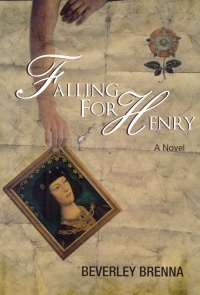| ________________
CM . . . . Volume XVIII Number 18 . . . . January 13, 2012
excerpt:
Falling for Henry, a blend of the historical and time travel genres, has as its theme the difficulty of coping with death, loss and discomfort. As the novel opens, Kate, an American teenager living in London, England, is on a field trip to the museum in London's Royal Naval College. Kate decides to skip the museum and check out the opening of the walking tunnel under the Thames. She has claustrophobia and hopes that by familiarizing herself beforehand, she can ward off a panic attack later when she rejoins her class and goes with them through the tunnel back to school. Author Beverley Brenna vividly evokes what it might feel like to time travel. Taking refuge from the rain in the tunnel mouth, Kate suddenly feels "the world revolving as thought she were on a ride at the fair...being subtracted from herself until nothing was left." She emerges in sunny woods where men and women in colourful period costume are hunting with bows and arrows. Dazzled by a graceful youth who brings down a deer, she is soon sickened when he cuts the animal's throat. She runs back to the tunnel, stumbles over a wolf cub, hears wolves howling, and lurches back into the 21st century. This experience is a foretaste of a subsequent longer visit to Tudor England, but first the reader must know Kate's 21st century circumstances. Her anxieties started when she was a young child in New York and her mother left the family. Kate is in London living with her elder sister following their father's death in a car accident for which Kate blames herself. Her sister, a student at the Royal Academy of Dramatic Arts, is worried about finances, so the girls subsist on soup in a cramped apartment. Friendless and anxious, Kate badly needs a change of scene. Will Kate prefer Tudor England to the 21st century? At first, it seems so. She says, "I'm better off here, reaching for joy." Yet her new environment has its challenges. She finds herself mistaken for Princess Katharine of Aragon, the young widow of Prince Arthur, King Henry VII's elder son. Katharine is in limbo. She cannot go back to Spain because King Henry VII wants her dowry to remain in England, so she is waiting for the king's second son, the teenaged Prince Henry, to propose to her. Confused about this new identity, Kate improvises, attributing her fuzzy memory to a recent illness. Eventually she finds Katharine's thoughts in her head. One senses that Kate may be Katharine reincarnated, particularly on learning that Kate's mother was "Isobel" and Katharine's "Queen Isabella." Yet Kate retains enough of her 21st century personality to dislike the physical grubbiness and the patriarchal attitudes of 15th century England. She hopes to talk Prince Henry (the future King Henry VIII) into "more modern ideas" about the role of women! While she admires the prince's charm, talent and courage, she feels more comfortable with one of Henry's gentlemen of the Privy Chamber, a gentle, rural born youth named William. Two promising characters introduced at the beginning are never developed. Kate's grandmother in Brighton might have been a source of wisdom and guidance, but she appears only briefly. More important is Kate's mother whose disappearance seems at the root of Kate's anxieties. Is she dead? Alive somewhere? The reader never finds out. The title, Falling for Henry, and the blend of two potentially romantic genres historical fiction and fantasy lead the reader to expect an exciting tale of transformation through young love, but the tone of the novel is troubling and sad. Kate is not transformed but emerges determined to make the best of things. The time travel/reincarnation theme provides a ray of joy at the end. Recommended. Ruth Latta's next novel, The Old Love and the New Love, to be published in 2012, is a blend of three genres: romance, comedy and action/adventure.
To comment
on this title or this review, send mail to cm@umanitoba.ca.
Copyright © the Manitoba Library Association. Reproduction for personal
use is permitted only if this copyright notice is maintained. Any
other reproduction is prohibited without permission.
NEXT REVIEW |
TABLE OF CONTENTS FOR THIS ISSUE
- January 13, 2012.
AUTHORS |
TITLES |
MEDIA REVIEWS |
PROFILES |
BACK ISSUES |
SEARCH |
CMARCHIVE |
HOME |
